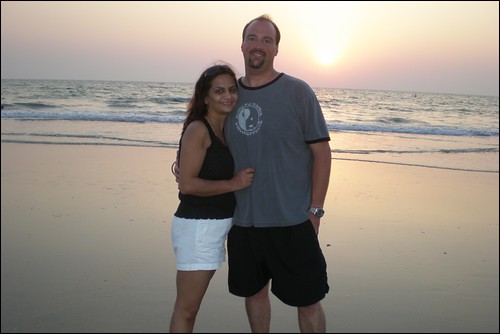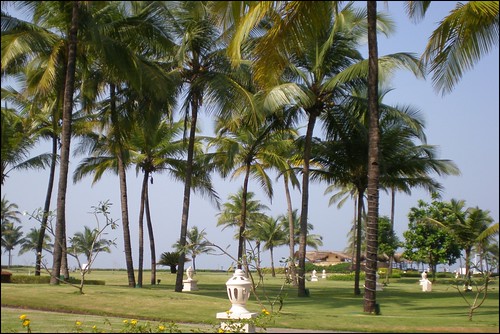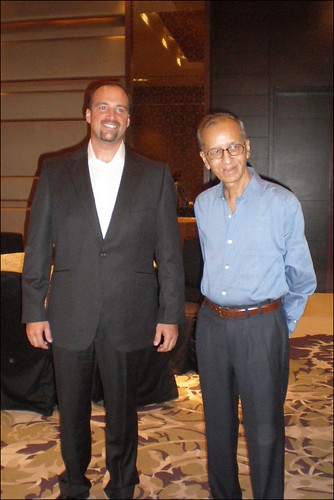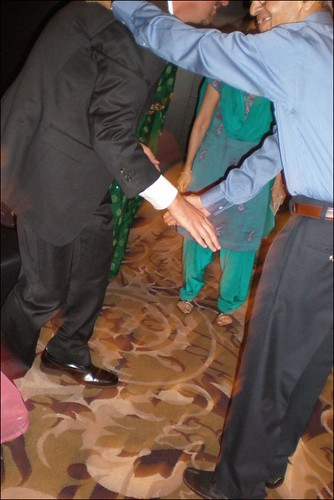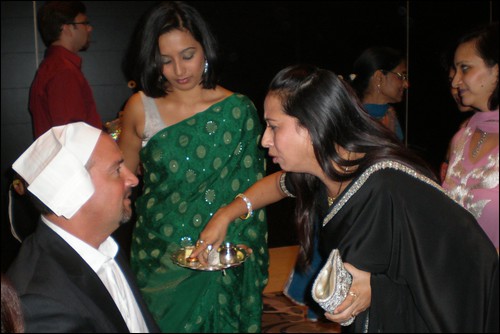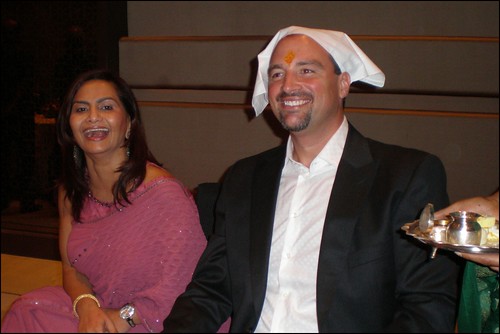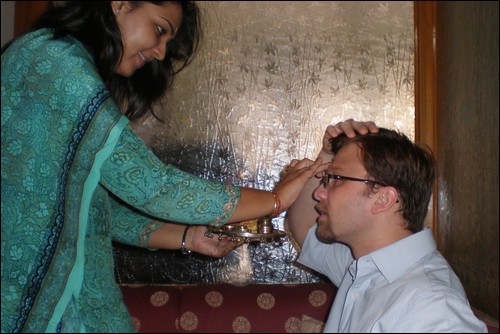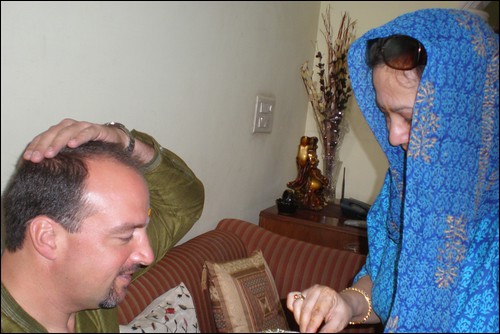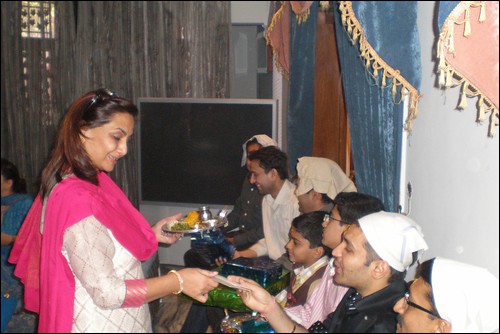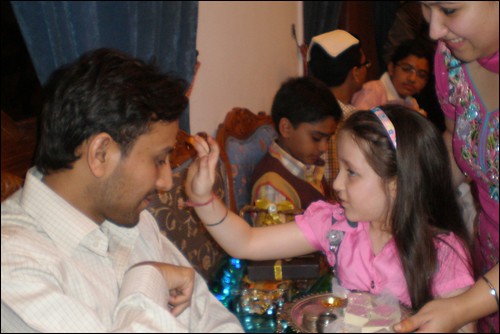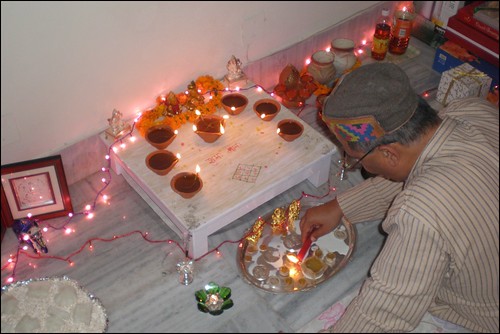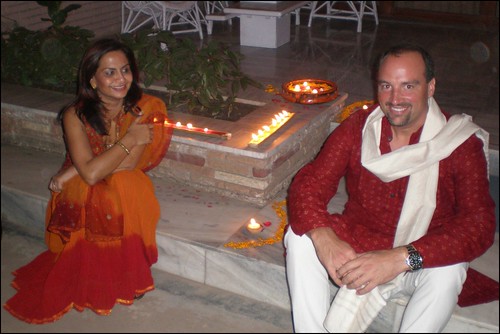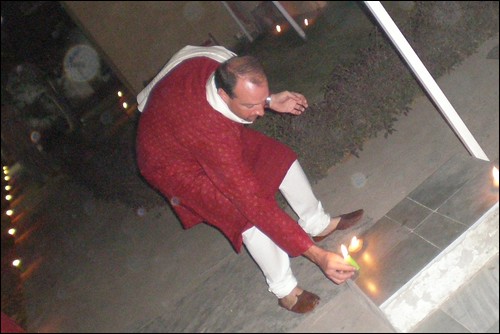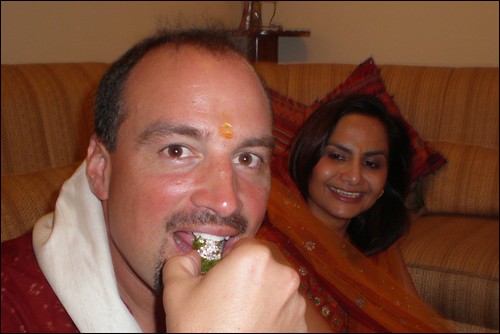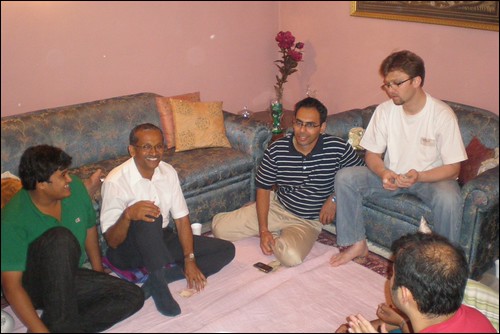"Where are you from?" is a difficult question for me to answer. My answer now is "Bangalore, India," to which I am just as attached as I am to Berkeley, California or Newport News, Virginia, or just about anywhere else. I was born in California, lived in several states, but I suppose I was raised in South Texas. Even within Texas as a boy, I lived in several places. For Anjali, answering that question is easy. She is from Amritsar, and we were fortunate to be able to visit just after Diwali.
Golden Temple Mail
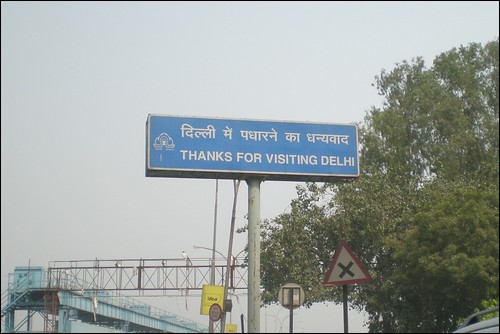 Bye Delhi
Bye Delhi
To get to Amritsar, we took an overnight train out of Delhi. This was the best way to make the trip, because even if we flew we would have had to subtract airport time from our day in Amritsar. Already exhausted from things we had done in the previous days, we slept through the entire ride without any trouble, arriving refreshed. Anjali's dad picked us up at the station, and within fifteen minutes we were at his home.
 The Golden Temple Mail train
The Golden Temple Mail train
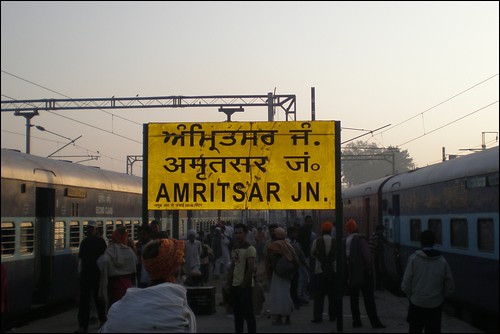 Good morning, Amritsar
Breakfast and Lassi
Good morning, Amritsar
Breakfast and Lassi
Our first stop was to enjoy breakfast, some delicious
channa puri. A bowl of greasy, spiced potatoes came out and we poured from that right into the beans. My taste buds were having a great time, but my heart was sweating just thinking about the arterial clogging.
 My first Punjabi breakfast
My first Punjabi breakfast
After breakfast, Anjali's dad took me to a roadside spot to have me try
lassi. Friends at work had been telling me that the best lassi is found in this area of India because of the high quality milk. The preparation has a dollop of butter on top of some heavy cream. I am not the biggest fan of yogurt, so the drink was something I am happy to say I tried, drank the entire serving and would not likely order one again.
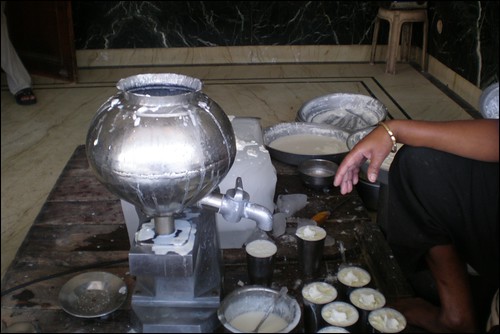 Check out the butter on top of each cup of lassi
Harmandir Sahib
Check out the butter on top of each cup of lassi
Harmandir Sahib
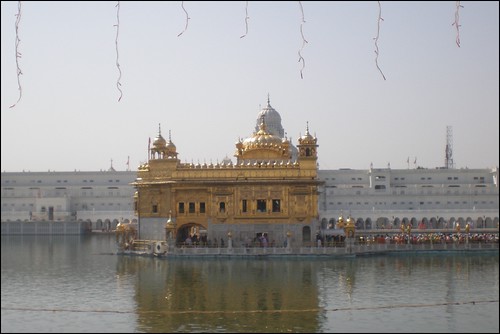 Harmandir Sahib: The Golden Temple
Harmandir Sahib: The Golden Temple
The city of Amritsar gets its name from Amrit Sar, the body of water surrounding the Golden Temple. Amrita is what the gods drink, a nectar which grants them immortality. Sarovar is a body of water surrounding a temple. Translated, Amritsar means
The Pool of the Nectar of Immortality. The Golden Temple, properly known as Harmandir Sahib, is the central temple, or gurudwara, for Sikhs. Each year, more people visit Harmandir Sahib than Taj Mahal! Though, I suspect a fair percentage of visitors to the Golden Temple are Sikh pilgrims, not all just tourists.
 A Sikh bathes in the sarovar
A Sikh bathes in the sarovar
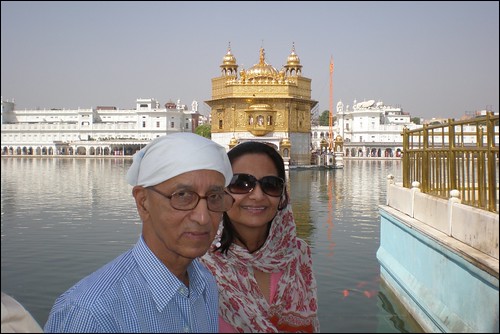 Anjali and her dad before the Golden Temple
Jallianwala Bagh
Anjali and her dad before the Golden Temple
Jallianwala Bagh
A short stroll from the Golden Temple, we visited the site of the
Jallianwala Bagh Massacre. In 1919, soldiers fired on unarmed civilians, which had assembled to protest high taxation. The orders came from Reginald Dyer, who coldly reported later, "I think it quite possible that I could have dispersed the crowd without firing but they would have come back again and laughed, and I would have made, what I consider, a fool of myself." News of the incident, hundreds killed and more than one thousand wounded, spread throughout India and served as a catalyst to end British rule.
Kesar Da Dhaba
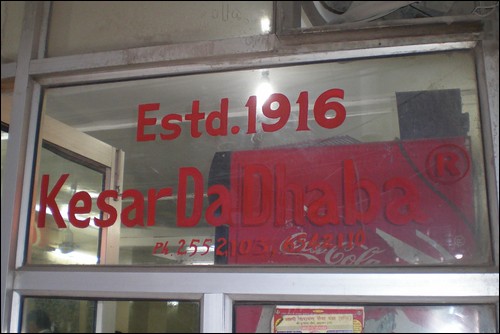 Kesar Da Dhaba has been serving Punjabi food since 1916
Kesar Da Dhaba has been serving Punjabi food since 1916
Anjali figured since I tried and enjoyed
sarson ka saag te makki ki roti (mustard greens with corn flat bread), I had become Punjabi. Qualifications started pouring in on what it would take for me to be a Punjabi munda:
- Must drink Amritsar lassi
- Have lunch at Kesar Da Dhaba
- Try galub jamon or fried fish from Lawrence Road
- Have kulcha channa
- Visit Southall in England
Note: I drank lassi. Lunch was delicious at Kesar Da Dhaba. I did eat something from Lawrence Road, but it was aam papar called "dead man's skin". Kulcha channa was homemade and was the last food I ate in Amritsar. Rajeev has certified me as a Punjabi munda, a Southall visit revoked as a necessity. Though, watch out Sanjeev and Monisha, we just might have to make a visit in early February!
So, we were at
Muni Lal Moti Lal Jaini, Anjali's dad's wholesale shop, and Sushil dropped by, inviting us to lunch. Now it was Anjali, me and two Sushil's (her dad's name too), on our way to Kesar Da Dhaba. From the shop, we walked down a narrow gali or two and we were there. Kesar Da Dhaba was great! The lacha paratha was dripping with ghee and the masala channa was spiced enough for me to enjoy it.
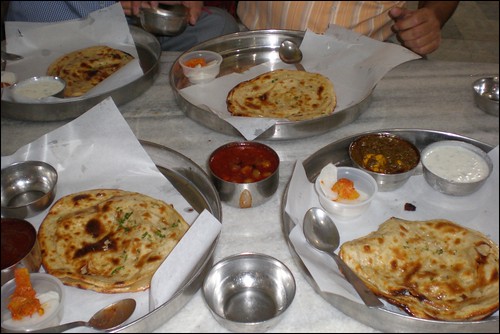 Delicious Punjabi food from Kesar Da Dhaba
Delicious Punjabi food from Kesar Da Dhaba
After thanking Sushil for lunch, I peeked into the kitchen. I was beckoned when they saw me taking a photo. Every time I took a picture, I was called farther into the kitchen to take another. I wonder how long I would have been there until I was asked to help cook and clean?
 Kesar Da Dhaba's kitchen
Border Show
Kesar Da Dhaba's kitchen
Border Show
Let's see, a full morning of walking about coupled with a huge lunch made for a great excuse for a siesta. So, Anjali's dad and I chatted for a bit one-on-one while Anjali slept and after a bit, everyone was snoozing. Now it was time to head to the Pakistan border for the daily ceremony, called
Lowering of the Flags. The military border guards from each country put on quite a show. It starts with music, people dancing and cheering. The Indian Border Security Force and the Pakistani Rangers "battle": who has the flashiest turban, highest kick, loudest marching stomp, etc. All this is performed in mirrored fashion and then the border gates are opened. The flags of the neighboring countries are then lowered in unison.
Neha's father works for the Indian government's Ministry of Transportation, and he arranged a treat for us. We were to be escorted by a government vehicle and given special seating close to the border gates. When the jeep arrived, I said, "I want to ride in that!" After getting some nod/permission, I was skipping off toward the vehicle. It was only after I had jumped in that I realized Anjali was planning to ride with me and not in the trailing car with her dad. This was not a bummer moment, but I was just too excited to even notice and be a gentlemen, helping her in or even letting her get in first. When traffic would get in our way, the siren would wail and we would cut through obstacles with ease. This was so much fun!
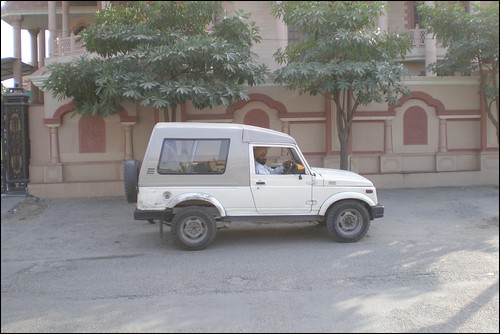 Our ride to the Pakistan border town of Wagah
Our ride to the Pakistan border town of Wagah
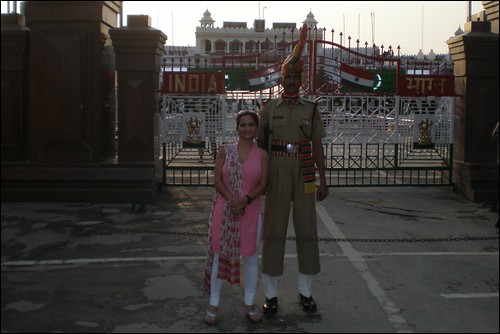 Anjali with a border guard
Anjali with a border guard
 Some kids race to the border gate with Indian flags
Some kids race to the border gate with Indian flags
No matter what I did, I could not get a photo of the Pakistani and Indian flags being lowered to come out. And, with the sun behind them, none of my shots of the Pakistanis in their grandstands came out either. You'll just have to take my word for it, this was an amazing event. Photos would not have done it justice regardless.
 Here you can see soldiers from both countries with open gates
Dead Man's Skin
Here you can see soldiers from both countries with open gates
Dead Man's Skin
The sun had set by the time we returned to Amritsar from the border. It was time to try some chaat from Lawrence Road. Sudev said that I had to try aam papar, which is dried mango paste, dried to the point where it has turned black or gray with the same appearance as dried skin. This is when it is called
dead man's skin, and sheets of it are cut into strips, rolled in spices and eaten. I actually liked it and purchased some which I brought back to Bangalore for people at the office.
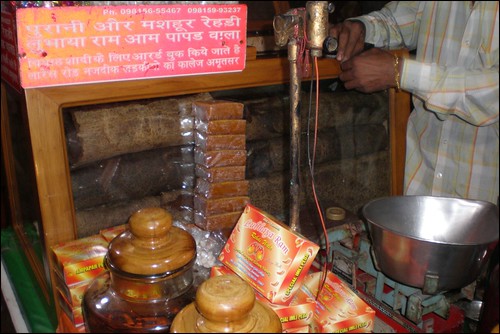 Dead man's skin in the display case of a roadside cart
Channa, Channa, Channa
Dead man's skin in the display case of a roadside cart
Channa, Channa, Channa
My quest to become fully Punjabi required kulcha channa. Kulcha channa is a bread, much like a hamburger bun, topped with spiced beans. This would be the third and final helping of channa for the day: started with channa puri for breakfast, lunch was lacha paratha with masala channa, now an evening course of kulcha channa.
Mein re bhet kharab ho gaya! Well, more proper to say
bhet bhar gaya, since I was full but everything was still in working order. It had to be, we still had some bhindi sabut to eat on the train ride. Some people stopped by to say hello, but our conversations were cut short in order for us to catch the train. A round of good byes and we were leaving Amritsar, headed back to Delhi.
 Rajeev offers some onion pakoda to Anjali
Rajeev offers some onion pakoda to Anjali
